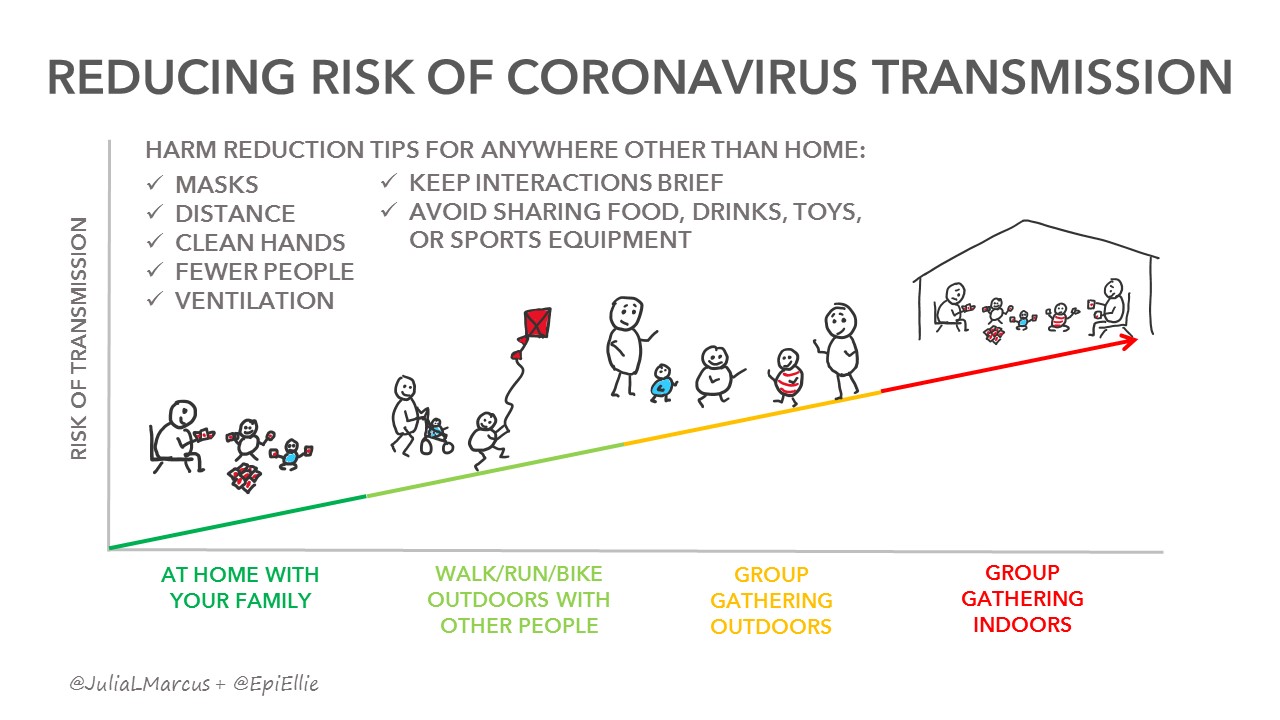
That little illustration comes from a twitter thread that I came across and thought I’d share with my readers:
It’s time to update the all-or-nothing messaging on Covid-19 risk.
Let’s give people the tools to understand that the riskiness of social activities lies on a spectrum.
We are staring quarantine fatigue in the face. We need new guidance–and policies–to meet this challenge.
1/ Strict sheltering at home in NY over the past two months succeeded, against the odds, in flattening the curve enough to prevent our hospital system from breaking at the apex. This avoided untold suffering.
2/ The risk of a rebound still looms, so we need to continue extraordinary measures to ensure physical distancing for the foreseeable future.
3/ But given the long road ahead, it’s simply not realistic that we tell people to indefinitely avoid all in-person social contact outside their household.
4/ If we don’t give people the information to choose low-risk activities, they will choose high-risk ones–like house parties, large gatherings in front of bars, or swimming at beaches without lifeguards. (All of which is already happening in NYC.)
5/ On the other hand, lack of clear guidance on relative risk means that some people overly focus on minor threats, like contamination from bringing mail or fresh produce into your home, or from someone passing you on a bicycle in the park.
6/ The growing consensus of scientists is that most transmission is happening in enclosed spaces during sustained contact. Yes any contact, in any setting, for any duration has some risk. And those who are most vulnerable need to be especially mindful of this.
7/ But it’s also true that:
* Outdoors is less risky than indoors.
* Small groups are less risky than large groups.
* Simply passing by someone is less risky than sustained contactSo let’s give people the tools to understand that risk is a *spectrum.*
8/ Epidemiologists @JuliaLMarcus and @EpiEllie have suggested conveying a spectrum of risk with a color-coded system like [the one above].
9/Instead of simply saying “don’t get together with your friends in the park”, let’s give people guidance on how to minimize the risk if they do so. (Keep the group as small as possible, don’t share food/drinks/utensils, and stay home if you’re sick)
10/ And let’s give people guidance on the level of risk–and how to minimize it–for activities like visiting parents, going on a walk with your friend, having a playdate for your kids, etc.
11/ NYC also needs policies to help minimize rising quarantine fatigue.
That means offering options that are less risky than crowded house parties–like safe plans for opening beaches and park sprinklers this summer (as long as we continue to reduce the rate of new infections).
12/ Coronavirus is not going away any time soon. So everyone needs to continue taking extraordinary measures to protect themselves and others–physical distancing, face coverings, hand washing, staying home when possible. But it’s time to update our advice for the long haul.
13/ To recap: Risk isn’t binary. And simply telling people to stay home is not enough. We need to give the public the tools to understand where their choices fall on a spectrum–so they choose the safer path. That’s our best shot for beating this virus.
14/14 This thread owes a lot to @JuliaLMarcus, who has been way ahead of the crowd in developing the idea of applying “harm reduction” to covid. Read her excellent article on the topic:
People like me will probably err on the side of caution for some time to come. We’re all healthy in my household but we’re not young and I really don’t want to get this thing — or if I have to get it I want to wait until they know a whole lot more about the virus and how to treat it. No hurry for me.
But I understand that younger, otherwise healthy, young people are simply not going to do that for much longer. It’s already breaking down substantially. So maybe if the lockdown is lifted with these guidelines shared widely, and the risks are made plain, the vast majority will do it smartly and with some concern for the more vulnerable people with whom they interact.
Sadly, the wearing of masks, which has been shown to make a big difference in the rate of transmission when everyone wears one is not taken seriously by way too many people. It’s probably partially the fault of the health care community which said in the beginning that masks were actually bad for you, so that’s a real pity. Lying to the public in a public health crisis is a very, very bad idea. But a lot of young people and right wingers don’t feel at personal risk and don’t seem to understand (or care) that they can actually spread it to others if they don’t feel sick.
Maybe if the messaging is different — if people can see that they don’t have to stay on lockdown but they need to use these common sense guidelines to protect themselves and others — it will help reduce the risk for everyone.